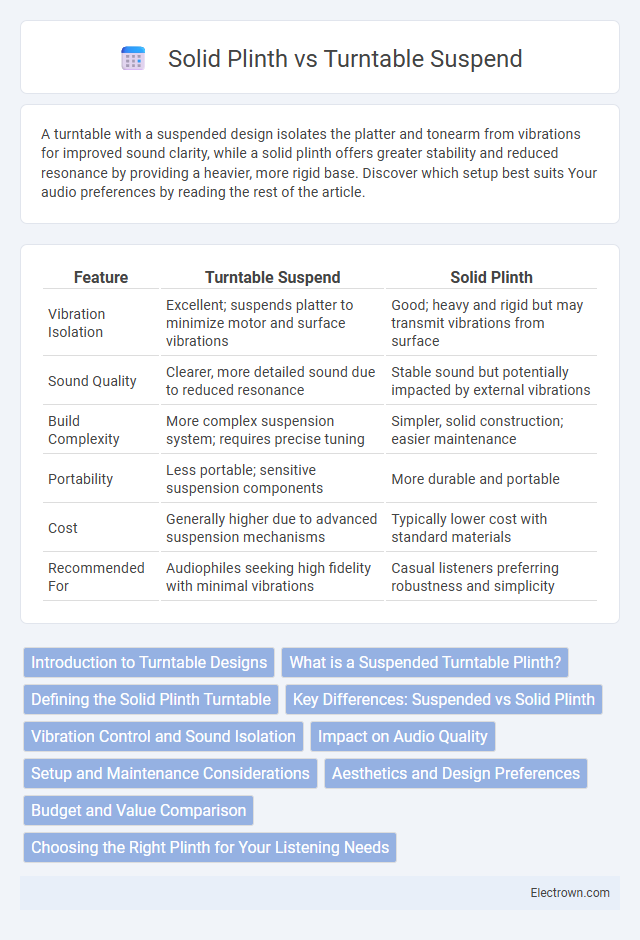A turntable with a suspended design isolates the platter and tonearm from vibrations for improved sound clarity, while a solid plinth offers greater stability and reduced resonance by providing a heavier, more rigid base. Discover which setup best suits Your audio preferences by reading the rest of the article.
Table of Comparison
| Feature | Turntable Suspend | Solid Plinth |
|---|---|---|
| Vibration Isolation | Excellent; suspends platter to minimize motor and surface vibrations | Good; heavy and rigid but may transmit vibrations from surface |
| Sound Quality | Clearer, more detailed sound due to reduced resonance | Stable sound but potentially impacted by external vibrations |
| Build Complexity | More complex suspension system; requires precise tuning | Simpler, solid construction; easier maintenance |
| Portability | Less portable; sensitive suspension components | More durable and portable |
| Cost | Generally higher due to advanced suspension mechanisms | Typically lower cost with standard materials |
| Recommended For | Audiophiles seeking high fidelity with minimal vibrations | Casual listeners preferring robustness and simplicity |
Introduction to Turntable Designs
Turntable designs typically feature either a suspended or solid plinth, each influencing sound quality and vibration control. Suspended plinths use isolation mechanisms such as springs or elastomers to minimize external vibrations, enhancing audio fidelity by reducing resonance. Solid plinths rely on dense, rigid materials to provide stability and mass, which can improve tracking precision but may transmit more environmental vibrations compared to suspended designs.
What is a Suspended Turntable Plinth?
A suspended turntable plinth isolates the platter and tonearm from external vibrations by mounting them on a sub-chassis supported by springs or elastomers, enhancing sound clarity and reducing resonance. This design contrasts with a solid plinth, which is rigid and more susceptible to transmitting external vibrations, potentially impacting audio fidelity. Audiophiles often prefer suspended plinths for their superior vibration damping and improved overall playback quality.
Defining the Solid Plinth Turntable
The solid plinth turntable features a robust, dense base designed to minimize resonance and vibration, enhancing sound clarity and accuracy. Its heavy, rigid structure provides superior mechanical isolation compared to suspended models, resulting in improved playback stability. Choosing a solid plinth design ensures Your turntable delivers precise audio reproduction with reduced interference from external vibrations.
Key Differences: Suspended vs Solid Plinth
Suspended turntables use a suspension system to isolate the platter and tonearm from external vibrations, improving sound clarity by reducing resonance. Solid plinth turntables feature a heavy, rigid base designed to absorb vibrations through mass and damping materials, providing stability and strength. Choosing between suspension and solid plinth depends on your setup's environment, with suspended designs better suited for vibration-prone areas and solid plinths ideal for stable, controlled spaces.
Vibration Control and Sound Isolation
Turntable suspension systems use springs or elastomers to isolate the platter and tonearm from external vibrations, significantly reducing resonances and improving sound clarity. Solid plinth designs rely on dense, rigid materials like MDF or acrylic to absorb and dampen vibrations, providing stable sound isolation with minimal resonance. Effective vibration control in suspension setups targets low-frequency disturbances, while solid plinths excel in preventing structural coupling, both crucial for optimal audio fidelity.
Impact on Audio Quality
A turntable with a suspended plinth isolates vibrations more effectively, reducing resonance and enhancing audio clarity for a cleaner soundstage. Solid plinth designs provide stability and sturdiness, which can improve tracking accuracy but may transmit more external vibrations, potentially affecting audio fidelity. Choosing between the two depends on Your listening environment and priorities in balancing vibration isolation versus physical stability for optimal sound quality.
Setup and Maintenance Considerations
A turntable with a suspended sub-chassis offers easier setup and superior isolation from vibrations, reducing the need for frequent adjustments to maintain sound quality. Solid plinth models require precise leveling and a sturdy surface, often demanding more attention during setup to avoid resonance issues. Your choice depends on whether you prioritize minimal maintenance or a more robust, stable foundation for your turntable.
Aesthetics and Design Preferences
Turntable suspend designs offer a sleek, minimalist look with visible suspension components that appeal to those who appreciate technical elegance and modern aesthetics. Solid plinth turntables provide a more classic and robust appearance, often complementing traditional or vintage decor with their substantial, enclosed structure. Your choice depends on whether you prefer the airy, industrial vibe of suspended designs or the timeless, solid presence of a plinth base.
Budget and Value Comparison
Turntable suspend designs typically offer better vibration isolation by using springs or elastomers, making them ideal for audiophiles investing in high-fidelity sound without overspending. Solid plinth turntables provide a more rigid build, often resulting in greater durability and lower maintenance costs, which can offer excellent long-term value for budget-conscious users. Your choice depends on whether you prioritize enhanced sound isolation or a sturdier, cost-effective option within your budget.
Choosing the Right Plinth for Your Listening Needs
Choosing the right plinth for your turntable significantly influences sound quality and vibration control. A solid plinth offers superior stability and minimizes resonance, making it ideal for environments with minimal external vibrations. Conversely, a suspended plinth isolates the platter from external disturbances, enhancing audio clarity if your listening space experiences frequent vibrations.
turntable suspend vs solid plinth Infographic

 electrown.com
electrown.com